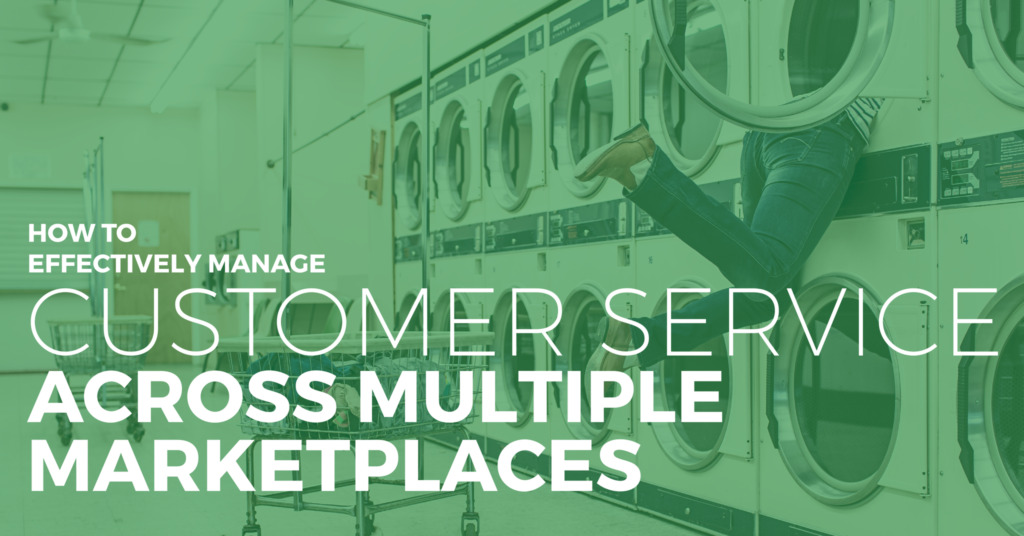In ecommerce, there’s only one thing worse than getting bad reviews, and that’s never taking the time to proactively and authentically respond to them.
Here’s the hard truth you need to accept: you can’t grow an ecommerce business (or any business, for that matter) without investing in customer service. It’s not possible anymore. In this day an age, when a bad review can haunt your Google results for months or an unhappy customer can plague your Facebook page with comments that damage your reputation and turn would-be customers away, you can’t afford to be lazy or indifferent when it comes to customer service.
But providing stellar customer service as an ecommerce business isn’t easy. For a brick-and-mortar business, customer service exchanges typically happen face-to-face or over the phone. But for an ecommerce business selling products on multiple marketplaces across the internet, complaints and messages from unhappy customers can show up everywhere—on your website, on your Amazon product page, on your Facebook page, on your Ebay listing, on your Etsy account, in emails, and really on any other platform and through any other channel you use to engage with customers and sell your products.
In order to maintain and strengthen your reputation, mend relationships with unhappy customers, keep current customers happy and loyal, and grow your business, you have to put a plan in place to effective manage customer service across multiple marketplaces.
Here are a few tips and tools you can use to build a winning customer service arm at your ecommerce business and ensure that no comments or questions from customers ever go left unanswered.
Best Practices & Tips
Tip #1: Encourage your customers to leave comments and reviews. The first crucial step you must take when you’re ready to start investing in customer service is to get the message across to your current and would-be customers that you actually want them to engage with you.
Here’s why:
Your customers are likely already having conversations with others about your company and products online—you just might not know about it, and if you don’t know about it, you don’t have the opportunity to participate.
Unless you’ve taken the time to really encourage the leaving of reviews and the asking of questions on your website and on the other marketplaces you sell your products on AND you’ve proven to be consistently responsive, your customers aren’t going to use those channels when they need help or want to voice their opinion. Instead, they’re going to have private or closed-off conversations with their friends and your other customers on Facebook, Twitter, Instagram, and other social media sites.
In order to become aware of issues, mend relationships, drive would-be customers to buy, you have to bring the conversation to you. To do it, all you need to do is give your customers and website visitors a little encouragement. For example, you should add copy and CTA buttons throughout your website that drive people to engage with you by leaving reviews and asking questions on your product pages. You should also spend time each day addressing new comments, questions, and reviews that appear on product pages listed in other marketplaces.
Your ultimate goal here is to show and prove to people that you care, and that you’re willing to listen and help.
Tip #2: Master the art of unforgettable customer service. Before you start diving head first into providing customer service for your ecommerce business, it’s important to educate yourself on best practices. There are a number of books and blog posts you can read to become a customer service pro. Here are a few recommendations worth checking out:
- 15 Customer Service Skills that Every Employee Needs by Gregory Ciotti for Help Scout
- The Secret Ingredient for Winning the Customer Service Battle in E-commerce by Michiel Gaasterland for KissMetrics
- The Master Guide to Advancing Your Customer Service Skills by Rob Wormley for When I Work
- The Customer Rules: The 39 Essential Rules for Delivering Sensational Service by Lee Cockerell
- Customer Loyalty: How to Earn It, How to Keep It by Jill Griffin
- Chief Customer Officer 2.0: How to Build Your Customer-Driven Growth Engine by Jeanne Bliss
- The Customer Delight Playbook: Delighting Your Customers Every. Single. Day. by Sujan Patel
Like any skill you want to practice and perfect in life or business, it’s always worth taking time to first educate yourself before taking any sort of initial action. The resources above will help put you on the right track and in the right frame of mind, and ultimately ensure that your interactions with customers are as real, as meaningful, and as mutually-beneficial as possible.
Tip #3: Let your personality and human side shine. When your customers have problems or need help, they don’t want to feel like they’re talking to a robot. It’s true that automation is an important part of scaling a business and improving processes as your business grows, but you can’t go overboard when incorporating automation into your customer service strategy. It’s recommended that you use tools that can help you better manage the entire process (more on that below), but you should avoid using automated or canned responses when engaging with customers on any marketplace. Your customers want to talk with people who care.
There are a number of resources you can check out to learn more about incorporating more personality and authenticity into your interactions with customers. Here are two to start with:
Resource #1: In a blog post on Help Scout titled, The Personality that Succeeds in Customer Support, author Gregory Ciotti recommends filling your customer service department with people who possess the following traits:
- Active listener
- Proactive
- Helpful
- Conversational
- In control
- Do-gooders
Ciotti goes deeper into each of these traits and really does a great job of explaining why each trait is important for effective customer service.
Resource #2: In a blog post on Groove titled, Using the Right Tone: What Louis C.K. Can Teach Us About Customer Service, author Len Markidan digs deep into the science behind tone of voice, referencing a number of studies and research in order to help readers ultimately understand how to best engage with customers. A few specific areas he touches on include:
- Understanding How Our Brains Process Tone of Voice
- Casual vs. Formal Tone
- Positive vs. Negative Tone
- Context-Specific Tone
It’s an incredibly meaty and insightful post, and definitely worth going through in order to better understand how your customers think.
Recommended Tools
With these tips and best practices in hand, your next step in building an effective customer service program for your ecommerce business is to adopt tools that help you reach and engage with customers across all your platforms. Here are five tools worth trying:
- ChannelReply – ChannelReply is a tool that integrates marketplace customer service messages and data with the CRM of your choice.
- Xsellco – Xsellco consolidates your incoming customer communications from your site, marketplaces and online stores, allowing you to never miss a message from a customer or would-be customer.
- Reply Manager – Reply Manager is another tool that you can use to consolidate, organize, and respond to all the messages you receive from customers across your website and marketplaces.
- Mention – Mention is a tool that you can use to monitor, manage, and respond to mentions of your brand or products as they come in across the web and on social media sites.
- Olark – Olark is a tool that you can implement on your site to offer live chat to your web visitors.
How else are you managing customer support across marketplaces? Tell me about them below in the comments.



6 thoughts on “How to Effectively Manage Customer Service Across Multiple Marketplaces”
Thanks William, this is a much needed article for me. I went camping for a weekend when first setting up my Amazon store and came back to 30 unread messages, I totally forgot about Amazon, all the other customer service emails synced to my phone.
I’m going to check out Channel Reply but to be honest not too impressed with the tools in this space, which makes for a great SaaS opportunity.
Yeah, I’ve had some luck with ChannelReply – sending it into Zendesk. I haven’t tried Xsellco yet but their at the top of my list to try next.
Thanks William, this is a much needed article for me. I went camping for a weekend when first setting up my Amazon store and came back to 30 unread messages, I totally forgot about Amazon, all the other customer service emails synced to my phone.
I’m going to check out Channel Reply but to be honest not too impressed with the tools in this space, which makes for a great SaaS opportunity.
Yeah, I’ve had some luck with ChannelReply – sending it into Zendesk. I haven’t tried Xsellco yet but their at the top of my list to try next.
Thanks William, this is a much needed article for me. I went camping for a weekend when first setting up my Amazon store and came back to 30 unread messages, I totally forgot about Amazon, all the other customer service emails synced to my phone.
I’m going to check out Channel Reply but to be honest not too impressed with the tools in this space, which makes for a great SaaS opportunity.
Yeah, I’ve had some luck with ChannelReply – sending it into Zendesk. I haven’t tried Xsellco yet but their at the top of my list to try next.